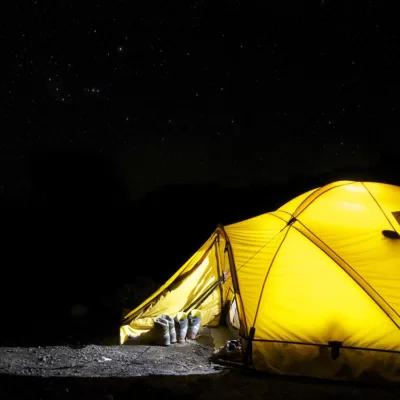One time, which was our first time, I and my buddies were so excited to spend some time in nature to enjoy the thrills of being surrounded by its wonder away from the hustle and bustle of the city you won’t believe that we didn’t know what to do when it got to pitching the tents!
We actually tried our best but since we didn’t know how to pitch a tent like a pro, we could only struggle to put the tent together and ended up with a flimsy structure. We were barely protected and only left feeling insecure and exposed to the elements all through the vacation, we even had to cut short the duration of our trip. Needless to say that this almost ruined our entire camping experience.
To enjoy a complete camping experience and explore all available fun things to do while camping, you need to be well protected, and one of the ways to ensure this is by pitching a tent like a pro; that way, it can’t be shaken by elements and will give you enough confidence to enjoy fun camping things with friends without worries.
Since this incident, and since I learned how to camp alone, I had to learn and master the art of pitching a tent like a pro as a lover of the great outdoors. Here in this guide, I have decided to share some of the dos and don’ts of a successful tent set up to guide the process and teach you how to pitch a tent like a pro.
Tips for Choosing the Right Tent for Easy Set Up
First, you need to choose the right tent for the number of people and the season of the trip you are going on a camping trip. This will mean that you have to consider the size, quality, and material that will suit the occasion. Here are some tips for choosing the right tent, if you must pitch your tent to fit.
Consideration of Size and Capacity
When choosing a tent, it is important to consider its size and capacity. Make sure to select a tent that can accommodate the number of people who will be using it, and allow enough room for personal gear as well.
Assessment of the Camping Environment
Before selecting a tent, consider the environment where it will be used. Factors such as terrain, vegetation, and potential exposure to wind and rain should be taken into account.
Consideration of the Weather Conditions
Consider the weather conditions of the area you will be camping in, and select a tent that can provide adequate protection from the elements and you enjoy some fun even when camping in the rain. Look for a tent that is suitable for extreme weather conditions, if necessary.
Importance of a Tent’s Weight and Pack Size
When camping, it is important to consider the weight and pack size of a tent. A lightweight and compact tent can be easier to transport and set up, especially if you are backpacking or hiking to your campsite. Consider a tent that is easy to pack and has a small footprint to minimize the impact on the environment.
Tips for Preparing the Tent Site
When you get to the campsite, the first thing to do when you are about to pitch your tent would be to prepare the site for pitching your tent. If you choose the wrong site, you may not be able to have a well-set-up pitch regardless of how good you are. Several elements will disturb you and your activities. On that note, it is best to follow these tips for preparing the tent site.
Find the Right Location
When preparing the tent site, the first step is to choose the right location. Look for a flat, level area that is clear of debris and vegetation, and that provides good drainage in case of rain. Try to find a site that is protected from strong winds and has a good view.
Clear the Area of Debris
Before setting up the tent, clear the area of any sticks, rocks, and other debris. This will make the ground more comfortable to sleep on and help prevent any damage to the tent.
Check for Uneven Ground
Check the area for any slopes or uneven ground and adjust the site as needed. A tent that is pitched on uneven ground can cause discomfort while sleeping and increase the risk of the tent collapsing.
Consider the Wind Direction
Take into account the wind direction when setting up the tent. This will help you orient the tent so that the entrance faces away from the wind, which will provide better ventilation and reduce wind noise.
Tips for Setting Up the Tent
Now here is where you get to be pitching a tent like a pro after all has been set and done. To set up a tent like a pro, you must know certain things and follow certain steps to have a well-pitched tent.
Understand the Tent’s Layout and Components
Before setting up a tent, it is important to understand the layout and components of the tent. Familiarize yourself with the tent’s poles, rainfly (if applicable), stakes, guylines (if applicable), and door and window zippers.
Knowing the different components and their functions will make setting up the tent much easier and more efficient. The tent should have a clear diagram or instructions included with the package, which can be helpful to consult before starting the setup process.
Set Up the Tent’s Poles
Setting up the tent’s poles is the first step in setting up the tent itself. This process involves assembling the tent’s poles and preparing them for use.
- First, determine the type of tent poles you have and make sure you understand how to assemble them. Some tents come with pre-attached poles, while others may require you to snap or twist sections of poles together. Refer to the manufacturer’s instructions for specific details on how to assemble your tent’s poles.
- Once the poles are assembled, place them at the designated corners of the tent. The tent should have grommets or sleeves that the poles will insert into. Make sure the poles are correctly aligned with the grommets or sleeves and insert them until they are fully seated.
- Next, raise the poles to create the tent’s structure. If your tent has a center pole, this should be raised first. Then raise the other poles until the tent is standing upright. Make sure that the poles are straight and that they are properly distributed to provide the necessary support and stability to the tent.
- Finally, secure the poles in place using the provided clips, buckles, or loops. Ensure that the poles are tight and secure and that there is no movement or wobbling.
Attach the Tent to the Poles
Attaching the tent to the poles is a critical step in setting up a tent. This process involves attaching the tent body to the poles so that it is taut and sturdy.
- First, identify the corners of the tent and the corresponding poles that will be used to support them. Make sure that the poles are properly aligned with the tent’s corners and that they are inserted into the grommets or sleeves on the tent.
- Next, start at one corner of the tent and begin to secure the pole to the tent. This can be done using various methods such as clips, buckles, or loops. Make sure that the tent is securely attached to the pole and that there are no wrinkles or folds in the material.
- Repeat this process for each of the remaining corners of the tent, making sure that the poles are properly aligned and that the tent is securely attached to each one. When all four corners are complete, the tent should be taut and upright, with the poles providing the structure and support needed to keep the tent stable.
- Finally, check that all of the attachments are secure and that there are no gaps or slacks in the tent material. Adjust the attachments if necessary to ensure a snug and secure fit.
Stake Out the Tent
Finally, stake out the tent by inserting the tent stakes into the ground at the designated points around the tent. Make sure that the tent is properly tensioned and that the guylines (if applicable) are secure. This will help to ensure stability and prevent the tent from collapsing in windy conditions. When staking out the tent, make sure that you are using the correct stakes for the ground type.
For example, if the ground is soft, you may need to use longer stakes, while if the ground is hard, you may need to use thicker or heavier stakes. Additionally, it’s important to make sure that the tent stakes are not too close to the tent walls, as this can cause the tent to collapse inward.
Read also Everything you Need to Know About Camping Tents and Shelters
Securing the Tent’s Rainfly (if applicable)
If your tent has a separate rainfly, it is important to secure it properly to ensure that your tent stays dry in the event of rain.
- First, make sure that the rainfly is properly attached to the tent and that it covers the entire tent, including the doors and windows. This can usually be done by zipping the rainfly to the tent or by using buckles or clips.
- Next, adjust the tension of the rainfly to ensure that it is taut and does not have any wrinkles or folds. This will help to prevent water from seeping through the material and into the tent. Some rain-flies have guylines that can be used to further secure the rainfly and prevent it from sagging or collapsing. Make sure that the guylines are properly tensioned and that they are not too tight or too loose.
- Finally, if your tent has a vestibule or an area that is covered by the rainfly but is not part of the tent’s interior, make sure that the rainfly is properly secured over this area as well. This will help to prevent water from seeping in and provide additional space for gear storage.
Dos and Don’ts of Tent Setup
There is a list of things you should and shouldn’t do when pitching a tent like a pro. Following these tips and tricks will help you set up a sturdy and well-balanced tent that can withstand every element so that you enjoy some available fun things to do when camping with your friends.
Dos of a Tent Setup
- Choose the Right Tent: It is important to choose a tent that fits your camping needs and preferences. Consider factors such as size, weight, and weather conditions.
- Prepare the Tent Site: Make sure the area where you plan to set up the tent is clear of debris, level, and protected from the wind.
- Follow Manufacturer’s Instructions: Carefully read and follow the instructions provided by the tent manufacturer to ensure a successful and efficient setup.
- Stake Out the Tent: Make sure the tent is properly staked out to ensure stability and security.
- Use Guylines (if applicable): Guylines help secure the tent and provide additional stability in windy conditions.
Don’ts of a Tent Setup
- Don’t Pitch the Tent on Uneven Ground: Pitching the tent on uneven ground can result in discomfort and instability during the night.
- Don’t Leave the Rainfly Unsecured: The rainfly is an important component of the tent that provides protection from the elements. Leaving it unsecured can result in water damage and discomfort.
- Don’t Leave the Tent Stakes Loose: Loose tent stakes can result in instability and the possibility of the tent collapsing.
- Don’t Pitch the Tent in Low-Lying Areas: Pitching the tent in low-lying areas can result in water damage and discomfort during heavy rain.
- Don’t Ignore Weather Conditions: It is important to consider the weather conditions when setting up a tent, as it can greatly impact the tent’s stability and comfort.
Conclusion
Pitching a tent like a pro requires careful consideration and preparation. To set up your tent successfully, it’s essential to choose the right tent that suits your needs, prepare the tent site thoroughly, and follow the manufacturer’s instructions carefully.
Stake out the tent properly, use guylines, and secure the rainfly to ensure the tent is sturdy and safe. On the other hand, it’s important to avoid pitching the tent on uneven ground, leaving the rainfly unsecured, leaving the tent stakes loose, pitching the tent in low-lying areas, and ignoring weather conditions.



























